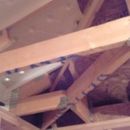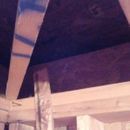Insulation Baffle in *corner* of hip roof
I am installing my insulation baffles for the attic. I have run into a problem. My roof is a hip style and the corners have a main bridge truss that the smaller guys attach to to form the corner. The first two immediate rafter bays in the corner have very little room. The next two on each side have a little more room as you can see, which I just cut the insulation baffle at an angle to fit in. I have a couple concerns, if I block the very corner bays, will I have trouble with moisture gathering there since there isn’t really any way air would flow along that spot…especially since I am channeling my air along my roof sheathing on the sides of these bays? Also, I have two bathroom fans I will vent to the soffit. I am wondering if blocking the bays the vent go out to the soffit is a good idea to prevent moisture from just flowing back up into the attic?
GBA Detail Library
A collection of one thousand construction details organized by climate and house part












Replies
Nicholas,
It's impossible to vent a hipped roof. If you want the insulation to follow the roof slope with this type of roof, you need to choose one of the unvented approaches.
For more information on unvented insulated roof assemblies, see How to Build an Insulated Cathedral Ceiling.
Hmm...Well.. I have a continuous ridge vent and have insulation baffles along the rafters that they fit in. I only have problems with the corners. Should I just block the corners off? Or should I leave just a tiny gap that would allow air flow and just not install insulation past that height (raised heel roof, so I may not need insulation to that height).
There has to be a standard method because this is how all the houses o see are done. I never see the baffles but I always see a ridge vent and soffit vent on hip roofs.
Nicholas,
Hipped roofs have ridge vents because most hipped roofs have vented unconditioned attics. These attics are easy to vent.
Once you start stuffing insulation between the rafters, however, things get complicated.
I don't doubt that some ill-informed builders have tried to install ventilation baffles in hipped roofs. But you can't do it. If you do, you risk moisture accumulation and rot -- unless you switch to spray polyurethane foam.
Nicholas,
I'm confused - and maybe Martin is too: Are you insulating each bay, or just the ceiling of the attic?
Haha, I am sorry....I am insulating the attic floor! I am just not sure how I can get the required 1 to 2" gap between roof sheathing and my insulation in these corners of the hip roof since my baffle does not work there... After your second post Martin, I realized you misunderstood and Malcolm made it apparent.
Nicholas,
Don't worry about it. That small area will dry even if in contact with the roof sheathing. If you look at professionally insulated roofs they often only place baffles in every other truss bay - and this doesn't present any problems as long as the required volume of ventilation necessary at the soffits is met.
Edit: Looking at your pictures again, I'd be tempted to remove the baffles in the second bay too, as there is nowhere at the peak for the air to exit.
Malcolm, I was planning on trimming the baffle some more on the second bay. I just trimmed the angle to get it installed. I think my insulation height will only touch about halfway up the insulation baffle. I have to meet code R-38 in zone 5. I'd like to do R45 or R50 if time/money permits. That will require 12 to 16 inches of space. I really don't want to leave the 3.5" of void between roof sheathing and wall sheathing. Can I get away with completely sealing those corners or should I still try to get some air space? I am thinking I could put some osb up to cover the 3.5" x 22.5" air gap that either the baffle or 'bird blocking' would typically fill and then stuff the corners full of insulation.
I think you are better off filling them with insulation. The moisture is going to diffuse through the cellulose and dry into the air in the attic. There is no real benefit to supplying an air space unless it has air movement through it.
Okay. I will block off the kneewall in the immediate corners. I suppose I better leave the second rafter bay over the way I have it with some venting as long as I cut the baffle back 8 to 10 inches so air has a channel. Thanks!
Nicholas and Malcolm,
Yes, I misunderstood. Thanks, Malcolm, for clarifying the issue.
Malcolm is right -- if you are installing insulation on the attic floor, it isn't essential to have a ventilation baffle in every rafter bay. Ventilation in this situation is much less important than it would be if you were insulating the sloped roof assembly.
Okay. Just some food for thought. I have so far installed baffles along the entire length of one side. If I were to start doing every other, would this likely cause an issue with unbalanced venting?
I was reading articles about air sealing the baffle or it isn't really worth using. Is the quickest way to do this by using expandable foam on the corners and cracks of the baffle?
Nicholas,
Canned spray foam is indeed useful to seal air leaks around these ventilation baffles.
For more information on these issues, I suggest that you read these two articles:
All About Attic Venting
Site-Built Ventilation Baffles for Roofs